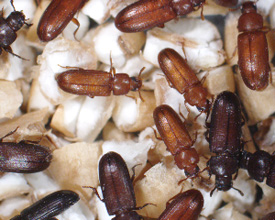A bug’s life—examined
A practical pest, the red flour beetle has swarmed Michael Wade’s lab for decades.
By Leigh Krietsch Boerner
Photography by Susan J. Brown
Evolutionary geneticist Michael Wade, PhD’75, has been studying Tribolium castaneum—the red flour beetle—for most of his 35-year academic career. “They’re just such a great model,” says Wade, a distinguished professor of biology at Indiana University, who inherited his penchant for these tiny bugs, found in stored grain, from his graduate adviser, former colleague, and mentor, Thomas Park, SB’30, PhD’32. “You can study so many different problems, from evolutionary genetics to ecology to behavior, with one organism.” And Wade has: his beetle studies have helped earn him an October 2008 induction into the American Academy of Arts and Sciences.
 An ideal subject for genetic studies, red flour beetles infest stored grain.
An ideal subject for genetic studies, red flour beetles infest stored grain.Beetles are highly diverse—with more than 350,000 different species—and evolutionarily successful animals. With a generation time of only four to 12 weeks, the red flour beetle is almost an ideal subject for evolutionary problems. In 2007 the Tribolium Genome Sequencing Consortium mapped 90 percent of the insect’s genetic sequence, making it even more valuable to researchers. It’s a more broadly applicable model than the commonly used Drosophila, or fruit fly, Wade believes, because Tribolium gene content and function have more in common with other insect systems.
Wade, a Quantrell Award–winning former Chicago professor, studies how the beetles’ evolutionary processes change different populations’ genetic composition—how evolutionary changes happen, how they help individuals survive and reproduce, and how genes interact to produce a particular trait. One of his biggest contributions to evolutionary genetics involves group selection, says Stephen Shuster, a professor at Northern Arizona University, collaborator, and former postdoctoral researcher in Wade’s lab. Group selection, the idea that certain genes are present in a population because they are good for the entire group, regardless of how the gene affects an individual, is somewhat controversial among evolutionary biologists—natural selection acting at the level of the individual beetle is still the more traditionally accepted theory. But in the mid-1970s, Wade “provided first-hand evidence” that showed group selection takes place in the lab, Shuster says. By selecting genetically similar groups of red flour beetles according to a large or small number of adults in a subpopulation, he found a significant and rapid—over three or four generations—response to group selection.
Recently Wade has started attacking a new problem: how do the genetics of a single-species beetle population diverge to become incompatible? To do this research, he and former student Jeff Demuth have been awarded a $2 million, four-year grant from the National Institutes of Health.
“We’ve discovered in preliminary studies,” Wade says, “that beetle populations separated by only a few hundred miles from one another produce inviable, infertile, or deformed hybrid progeny.” After a relatively short period of time, two beetle populations can no longer interbreed. According to Wade, it’s not any single gene that causes the incompatibility; it’s the combination of certain genes, like the interplay of genes in human disease.
Several common human conditions—diabetes or autism, for example—are likely caused by bad gene interactions, Wade says. But “the problem for health scientists now is that we don’t know a lot of about the gene combinations that produce disease.” He hopes to learn more about bad gene combinations in beetles, so the information can be applied to human disease systems.
Researchers have found single genes that, alone, cause a particular disease, an idea known as the single-gene model. But finding evidence for many diseases using this premise has proved difficult. “You might find that the same gene contributes to disease in some people,” says Wade, “but to health in others.”
The difference between the single-gene and combination models is like the difference between two card games, he explains. The first theory is like War. “In that game, a low card is always low and a high card is always high.” But gene combination is more like poker: “Although an ace tends to be a good card, an ace of the wrong suit can ruin a flush, or an ace out of numerical order can ruin a straight.”
Along with researching the genetics of red flour beetles, he has also studied fruit flies, sea horses, plants, ants—all selected based on the interests of his students. He gets especially excited if a student wants to study an organism Wade knows nothing about. “There’s hardly anything that’s not appealing,” he says, in evolutionary genetics. “New predictions let you make new tests, which let you make new predictions. It’s kind of fun.”
WRITE THE EDITOR
E-MAIL THIS ARTICLE
SHARE THIS ARTICLE
RELATED LINKS
RELATED READING
- “Quantrell Award: Michael Wade”
(Chicago Chronicle, May 26, 1994) -
“Group Selections Among Laboratory Populations of Tribolium” (PNAS, Dec. 1, 1976)
- “Red Flour Beetle’s Genome Sequenced for the First Time” (Science Daily, Mar. 26, 2008)
